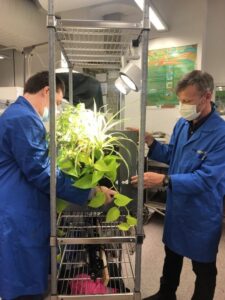
Plants versus pollution
Research proves green walls offer more than good looks
By Associate Professor Fraser Torpy and Dr Peter Irga
If you love that new-car smell, brace yourself. While that smell evokes feelings of fresh and new, it’s the byproduct of materials like paint, carpet and plastics leeching potentially carcinogenic compounds such as benzene into the air.
These materials are found all around our built environment, from our homes to our workplaces and our vehicles. The cumulative effect is that indoor air can have two to five times the concentration of pollutants than outdoor air. If people think if it’s polluted outside, they will go indoors, but in many cases, that only makes their problems worse.
One of the challenges we have is people thinking the new smell is associated with new things, and therefore it’s good. But all of those materials are giving off these harmful gases, and they accumulate indoors, and ventilation or air conditioning systems can only do so much to remove them, however they are still there, in often unhealthy concentrations.
So, what can we do about it? To answer this question, UTS researchers looked to something that has a proven track record of improving air quality, while also being eco-friendly: plants.
A silent threat
Plants’ potential to improve the quality of our indoor spaces is well studied. Decades ago, NASA even explored the idea of using plants to provide oxygen for astronauts on the International Space Station. They found oxygen levels increased, but they also made a surprise discovery. While the plants were expelling something helpful, they were also removing something harmful. What they found was that all these toxins in the air inside the space station was gone, and they worked out that it was the plants that actually removed the toxins.
We thought that could work in our indoor spaces as well, so we started looking at it from that angle. Twenty-something years since then, we’ve tested every type of air pollutant, and every type of plant we can.
In a world-first, this research looks specifically at pollutants found in petrol vapours. While not immediately harmful, the effects of inhaling these compounds over time has been shown to contribute to the development of cancer and other chronic illnesses.
We like the analogy of brushing your teeth. You’re not going to see overnight changes from brushing just once, but you will from continuously brushing your teeth.
It’s that consistent and persistent exposure to whatever the toxin is that has a cumulative effect.
Petrol vapours, surprisingly, are found in high concentrations in indoor spaces because of the popularity of underground car parks and, concerningly, attached garages in residences.
In studies where the effects were measured, it was found that the biggest source of highly dangerous carcinogens in non-smoking individuals was in the car garage. When someone starts up their engine, they’re creating volatile compounds from petrol vapours and they are going straight into the buildings. However, it’s not just petrol fumes from vehicles that are the culprit. Air pollutants can be generated from carpet, lacquer and paint, plastics and other synthetic materials. We can’t fix building design – we do plants and air quality, so the experiment became obvious.
Small but mighty
We work in the growing field of using nature-based systems to address air pollution, the urban heat island effect, biodiversity and a host of other challenges. More than a decade ago we teamed up to research how green infrastructure can be about function as much as form. Irga has an engineering background, while Torpy has a background in biotechnology and microbial ecology, while research scientists Gabrielle Duani, Stephen Matheson, Luowen Lyu and Ralph Fares provide the laboratory expertise needed to turn concepts into accurate data. Using our combined expertise makes for a formidable force. This research collaboration was further strengthened through a partnership with Ambius, a leader in indoor plantscaping solutions.
This mix of expertise and experience was particularly useful in devising experiments to test plants for their air-filtering abilities, as well as translating the results into practical solutions.
There are roughly 120 different chemicals within petrol, so first the team needed to work out the rates at which each chemical is filtered out. The team placed Ambius green walls comprising different plant species within their custom-built sealed chambers and subjected them to petrol fumes. Various configurations, types of air flow and plants were used to test different scenarios. Gas chromatography-mass spectrometry and photoionisation detectors determined the chemical composition of the air within a set timeframe after exposure. We were astonished by our findings.
Results showed the plants were able to remove nearly all of the most toxic petrol-related compounds from the air within eight hours. Even more astounding, the plants preferentially degraded and removed the most dangerous chemicals first, including benzene, toluene and alkanes (sometimes called paraffins).
Contrary to what you might think, the main method of pollutant removal is not through the leaves. It is bacteria housed in the plant’s roots called the rhizosphere that do the dirty work. The pollutant removal is not characteristic of specific bacteria, either. There are billions of bacteria in soil and millions of species, so it’s this whole community that’s operating here.
We’re currently running experiments to see how that community responds to pollutants and how we can encourage those specific bacteria so that we can increase the rate in which plants remove air pollutants.
Green is good
The impact of this is that green walls aren’t just decorative, but a promising technology. However, a challenge remains: how to set up these living filtration systems inside actual work and living spaces.
According to the researchers, you might need as many as 200 plants to filter the air inside a space, depending on the pollution types present. Most office spaces or homes are lucky to accommodate only a handful given available floor space. That’s our greatest barrier: the plausibility factor.
With horizontal space at a premium, the only viable solution is to build vertically. Working with industry partner Ambius is allowing the team to take lessons learnt from this research and trial different methods for constructing active green walls in a real-world context.
The team has been experimenting with green walls placed near air vents and HVAC systems to draw air through the plant substrates. This exposes the bacteria in the rhizosphere to toxins in the air and provides ample opportunity to degrade and filter them. Researchers are also exploring different substrate combinations to ensure that plants placed near air vents aren’t unintentionally introducing different harmful particles into the air, such as mould spores. We’re not saying strap a fan to any green wall. We’ve done substantial R&D on substrate development to have a system more or less optimised for air pollutant removal.
Another option being explored is to place plants as part of green roofs, again near air intake units to ‘pre-filter’ the air before it’s drawn into the building. For a fully integrated green solution, the team even recommends co-locating plants with rooftop solar. In this scenario, the plants do double duty. They help filter out toxins in the air while keeping the solar panels cool enough to operate at their most efficient temperature range.
Although there is still work to be done, we envision a future where indoor and outdoor spaces are completely bathed in green. Every time you picture a future city in your mind, what does it look like? It looks like a utopia that’s covered in plants, even if that’s idyllic, even if that’s a vision, we’re working towards that vision.
Associate Professor Fraser Torpy,
Director of the Plants and Environmental Quality Research Group
Dr Peter Irga,
Senior Lecturer, School of Civil and Environmental Engineering
University of Technology Sydney
